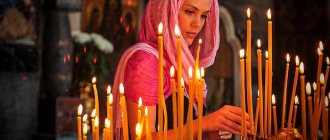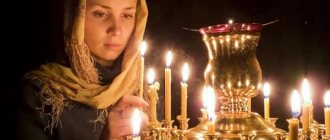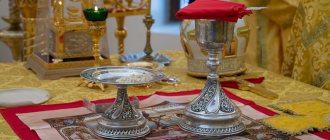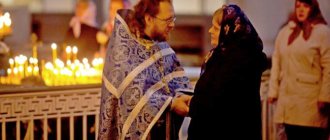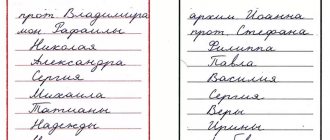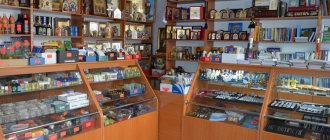Website of the Gorlovka and Slavic diocese
Probably everyone who visited churches and interacted with clergymen paid attention to their unusual headdresses. Why are they like this?
Everything in the Church is not accidental. This is very true: everything connected with worship has a symbolic meaning. The headdresses of priests were no exception. All of them symbolize the crown of thorns, which was put on the head of Christ the Savior during His suffering on the cross.
Priests' headdresses can be divided into everyday and liturgical ones. The first includes skufya, the second - kamilavka and miter. All of them have been known since ancient times, long before the birth of Christ, and were borrowed from the east.
Skufja
Skufya is an everyday headdress that a reader, a deacon, a priest, and a monk without holy orders have the right to wear. It is a soft cap, sewn in the shape of a cross and shaped like a temple dome. There are skufia for men and women, the latter are worn by nuns.
In ancient times, skufia were worn by wealthy or well-born people. We have never called this headdress! And a morocco cap, and a yarmulke, and an emolko - in total there are about ten different names. By the way, the eastern skullcap is the same skufia, only smaller, and the Jewish kippah is also a prototype of the skufia. I was surprised when I learned that the famous Monomakh hat is nothing more than a skufia, only decorated with precious stones, gold and trimmed with fur.
Skufia are worn not only by the clergy we have already mentioned, but also by bishops - they have a cross embroidered on the front of their skufia. Seeing such a distinctive sign, one can understand that this is a bishop, archbishop or metropolitan.
Mark of distinction
The priest's headdress also plays an important role in indicating the location of its owner in the church hierarchy. Thus, the miter, which resembles a royal crown, is worn exclusively by bishops, archimandrites and those clergy who are endowed with such a right for any merit.
A small soft dark-colored cap, skufya, is the everyday headdress of most clergy, monks and even ordinary lay people. Moreover, the purple skufia is also considered a reward.
A cylinder extended at the top, kamilavka, is worn by representatives of the white clergy during services. The hood (the same cylinder as the kamilavka, only with a train) is worn by monks. The doll with a cross at the top is the headdress of the patriarch.
Kamilavka
Kamilavka is a headdress that is used during worship. The priest can also wear it to a reception with the bishop or some kind of celebration. It looks like a cylinder, expanding towards the top. They put it on at a certain moment in the service - at the beginning of the Divine Liturgy, when the hours have ended, and do not take it off until the reading of the Gospel. Then the priest serves without it and puts it on only at the end.
Kamilavka is also an ancient headdress that is still used by many peoples. It is also known that it was worn by Byzantine emperors and dignitaries close to him. In our Church they began to wear it at the same time as skufia - under Patriarch Nikon.
Kamilavka is also a church award. It can be purple and red. They are worn not only by the white clergy, but also by the black ones, that is, monks. If a basting—a long piece of fabric—is sewn to the kamilavka, the result is a monastic hood. Monks who have accepted the schema wear a kokol instead of a hood: it is embroidered with images of cherubs, and above their foreheads there is an eight-pointed cross and a calvary with a spear and a cane.
Bishops and archbishops also wear hoods; archbishops have a cross embroidered on the front. The Metropolitan's hood is white and also with a cross. Thus, by the appearance of the kamilavka we can determine what rank the clergyman is in front of us.
It is interesting that in our Church kamilavka is a reward. When a priest is awarded it, the bishop gives him a special certificate with his seal and signature. But in Greece it is an item of casual clothing that is worn every day.
Church vestments and attributes
Epitrachelion (from the Greek - on the neck) is the liturgical vestment of a priest in the form of a long, wide ribbon worn around the neck, which hangs almost to the ground and is made in the form of two separate strips connected at the locations of conventional buttons, since there are no loops. Six crosses are sewn onto the priest’s stole, according to the number of six sacraments he performs. A priest cannot perform a service without an epitrachelion.
Rod (staff) - in ancient images the Savior was represented as a Shepherd with a staff in his hand. The apostles were also depicted with a staff. Bishops are the successors of the apostles, therefore the rod is used by them as a sign of the highest pastoral authority. Abbots and archimandrites who head monasteries also use a staff. The bishop's liturgical staff is decorated with precious stones, patterns, and inlays. Everyday bishop's batons are much more modest. Russian bishop's batons are characterized by the presence of a sulka.
Zvontsy are small bells that are attached to episcopal liturgical vestments. The bells serve as a constant reminder to the priest of the need to proclaim the will of God.
Kamilavka (from the Greek - camel) is a headdress for clergy, which was originally made from camel hair. The kamilavka has a cylindrical shape and is slightly expanded at the top. Archdeacons, protodeacons and priests receive a purple liturgical kamilavka as a reward. The vestments of the cassock monk, as well as the liturgical vestments of the hierodeacon, include a black kamilavka.
Cowl - headdress of monks. The hood is a kamilavka, wrapped in a blanket (doll), the ends of which go down to the back. The patriarch and metropolitans wear white hoods, the rest of the monks wear black ones.
Pectoral cross - worn on the chest (on the chest), under clothing or on top of it, on a cord or chain worn around the neck.
Mantle (from the Greek - “veil”, “cloak”) - a long, sleeveless, cape reaching to the ground with a clasp only at the collar. Worn over a cassock. In ancient times, this was the clothing of wandering philosophers, doctors, and teachers. Subsequently, monks began to wear it. Now this is the clothing of both a bishop and a simple monk.
Ordinary monks have only black robes. The bishop's or bishop's robe is more spacious and longer than the usual monastic robe. Bishops have a purple robe, metropolitans have a blue robe, and the patriarch has a green robe.
Tablets are sewn onto the bishop's robe at the top and bottom front. Along the width of the mantle are three broad, bicolor bands called “sources” or “jets.” They symbolize the teachings coming from the Old and New Testaments. The bishop puts on the mantle during ceremonial processions, at the entrance to the temple, and during some services. When putting on liturgical robes, the robe is removed.
Miter is a headdress for bishops, archimandrites and priests decorated with gems and small images. The miter serves as a reminder of the crown of thorns placed on the Savior. The miter of a bishop is crowned with a cross, the miter of a priest with an icon.
Omophorion (from Greek - shoulder pad) is a wide ribbon with the image of a cross, which the bishop puts on his shoulders over other robes. One end of the omophorion falls from the front, and the other from the back.
A mantle is a detail of a clergyman's attire placed on the shoulders. The mantle has its own symbolic meaning - the wounded shoulders of Christ. Mantles are worn over sakkos, phelonions and surplices.
Orarion (from Greek - guard, watch, or from Lat. towel, lention, or pray) - a long strip of brocade or other colored material (from the same as the surplice). The deacon wears the orarion on his left shoulder, over the surplice. The orarion is secured with a loop on a button, and its ends fall in front and back almost to the floor. It means God's grace received by the deacon at the sacrament of the priest.
Eaglet is a round rug with an embroidered image of an eagle spreading its wings over the city. During the service, the eagle creeps under the feet of the bishop.
The club is a quadrangular, diamond-shaped plate, suspended at one corner over the sakkos under the phelonion on the right thigh of the bishop and archimandrite, given to priests as a reward. If you have a club, the legguard is worn on the left. The club symbolizes the spiritual sword - the Word of God. In the Greek Church, the club was worn only by bishops, who represented the image of Christ - the Heavenly Bishop. In the Russian Church since the 16th century. the club is presented as a reward (the sixth in a row) to the archpriests.
Panagia (from Greek - all-holy) is a small, round icon of the Mother of God or the Savior, decorated with colored stones, which is worn by the bishop over the sakkos, along with a cross on the chest as a symbol of episcopal dignity.
The paraman is an ancient part of the monastic vestment - a quadrangle made of fabric with an image of a cross, which all monks wear on their backs under their everyday clothes. Ribbons or cords are attached to the paraman at the corners, which form a cross on the chest. The Patriarch's paraman is larger than usual and is therefore called great. Before the service, the Patriarch puts it on over his cassock.
The vestment is the lower liturgical garment of priests and bishops. During the liturgy, the cassock is put on the cassock. The vestment or surplice is the most ancient in origin and the common vestment for the priest and deacon. The surplice is a surplice in a slightly modified form and differs from the surplice only in that it is made of thin white material (usually silk), and its sleeves are narrow with laces at the ends, with which they are tightened at the wrists. Handrails are put on the vest's sleeves. A cross is sewn on the back of the cassock, and a stripe is sewn on the hem. The cassock also resembles the chiton (underwear) worn by the Savior himself.
The cassock is a long (to the toe) robe of the clergy with narrow sleeves and a buttoned collar. The cassock of monks should be black, the cassock of white clergy can be either black or light colors for summer.
Armbands are armlets, always worn by the deacon on the sleeves of the cassock or cassock, and by the priest in full vestment. The handrail is made in the form of a slightly concave strip of dense material, trimmed along the edges with a ribbon of a different color. A cross is depicted in the center of each arm.
The handrails cover the hand at the wrist and are tightened with laces threaded through metal loops that are tightly wrapped around the hand. While putting on the bands, a prayer is said, praising the power of God, with a request to enlighten the wearer. The handrails serve as a reminder of the bonds, the ropes that tied the Savior’s hands during His earthly suffering.
Pectoral cross
A chasuble (otherwise known as a phelonion) is a long, wide, sleeveless garment with an opening for the head and a large opening in the front, which allows free movement of the arms. Riza is a common, outdated name for the upper liturgical vestments of clergy. The chasuble is made of brocade with gold or silver thread.
The robe symbolizes the chlamys in which the suffering Christ was clothed. The longitudinal ribbons sewn on top are reminiscent of the streams of blood that flowed through His vestments. The robe symbolizes the robe of truth, which the priests put on as servants of Christ.
Sakkos is the bishop’s outer liturgical vestment made of expensive fabric, replacing the phelonion. The cassock and epitrachelion are visible from under the sakkos. Sakkos symbolizes the Savior's purple robe .
The cassock is a non-liturgical, outer, spacious, long vestment of the clergy with wide sleeves of a dark, mostly black color.
The tablet is a stone tablet with the Ten Commandments carved on them, given by God to the Jewish people. Tablets in the form of rectangles are sewn onto the bishop's robe at the top and bottom front. Crosses or icons are depicted inside the upper rectangles; the bishop's initials may appear in the lower tablets. The tablets mean that the bishop in his ministry is guided by the commandments of God.
Skufya is a small, pointed, black, folding cap, an everyday headdress of Orthodox monks and clergy.
The surplice is a long-skirted robe without slits with wide sleeves and a hole for the head. The surplice is the upper liturgical vestment of deacons, subdeacons, and, with the blessing of the bishop, of psalmists, sextons and laymen serving in the church.
The surplice is the upper liturgical vestment for deacons, and the lower one for priests, and in this case is called a chasuble, since a chasuble is put on top of it.
On the sleeves, shoulders and hem of the surplice, stripes of colored material or brocade are sewn, which symbolize the bonds binding the Savior being led to judgment, the bloody sores He received during torture, and the yoke or yoke of Christ, which the ministers of the church bear. A cross is depicted on the back, symbolizing the Cross that the Savior carried on His back to Golgotha. On the sides of the surplice, from the armpits to the waist and below, there are cuts symbolizing the perforated ribs of the Savior. The white color of the surplice (sacristan) is similar to the color of the heavenly robes of people and the Angels of God, and the color of the white vestments of the Lord at the Transfiguration.
Sulok - nested one inside the other and usually decorated with gold embroidery, two boards fastened in the upper corners with a cord, which are used to wrap the upper part of the staff at the handle. This decoration of the staff appeared due to Russian frosts. The lower board protects the hand from touching the cold metal of the staff, and the upper one from external cold air. See Rod
Felony - see Riza.
Chiton - the attire of the monks of the small and great schema, made of coarse fabric, hair shirt (hair shirt is a long, rough shirt made of hair or goat hair; ascetics wore it on their naked bodies). Worn under a cassock. In the rites, tonsure is called the tunic of free poverty and non-covetousness.
https://www.bogoslov.ru/text/2642051.htmlMiter
Miter is a liturgical headdress, the most beautiful and, so to speak, representative. This is also an award given to distinguished priests. After receiving it they are called mitered.
Miters were known in Ancient Greece and Ancient Rome. Surprisingly, it was originally an exclusively women's headdress. Then dandy men began to wear it. The orator Cicero in one of his speeches spoke about a fashionista who wore a miter.
Mithra symbolizes imperial power. The tradition of wearing it came to us from the Greek Church. It entered into liturgical practice there after the fall of Constantinople in 1453, and in our Church they began to use it at the same time as the skufia and kamilavka - at the end of the 18th century. Initially, miters were not given to the white priesthood - only bishops, archbishops and metropolitans, as well as abbots of monasteries, could wear them. The first award of a miter to a white priest occurred under Empress Catherine II: in 1786, she awarded her confessor, Archpriest Ioann Panfilov. Before the February Revolution of 1917, the miter was rarely awarded. The emperors had the privilege of granting it - it was they who signed the decree on such a reward. Now in this regard everything is much simpler, and we see that many priests wear miters.
The miter is decorated with icons of Christ, the Mother of God, John the Baptist and other saints (they can be different). On top of it is depicted either the Holy Trinity or the Cherub. The bishop's miter has a cross on top, but the priest's does not.
Priestly headdresses appeared in our Church quite late - during the church reforms of Patriarch Nikon, which were associated not only with printing and the correction of errors in church books, but also with many other issues. In particular, these reforms affected the clothing of clergy. The headdresses were adopted from the Byzantine tradition. They gradually became part of our liturgical practice and everyday life. We must admit that they were not immediately accepted, because, as we know, many opposed and hindered the reforms of Patriarch Nikon. Adherents of old traditions were alarmed by everything new, which is why the skufia, kamilavka and miter became common items of clothing for clergy lately - at the end of the 18th century, under Emperor Paul I.
Church headdresses are said to be “veils of humility”, this corresponds to the symbolism of the crown of thorns, but they have another symbolic meaning. The vestment of a priest is called his spiritual armor, because every Christian is a warrior of Christ, called to spiritual war not with flesh and blood, but with the spirits of evil. The priest is like an officer who leads these warriors. His miter can be compared to a spiritual helmet.
Why don't men wear hats at services?
At services we see that all the women stand in headscarves, and the priest wears either a kamilavka or a miter on his head. This begs the question: why don't men wear hats? The fact is that bareness of the head is a sign of humility. The New Testament Church took a lot from the Old Testament church: our churches were built in the image of the tabernacle, and the vestments of the priests are similar, and we also adopted the three degrees of priesthood from there. So the tradition of baring one’s head as a sign of humility came from there.
In conclusion, I will say that we are all called to salvation, and everything that surrounds us in the Church reminds us of Christ and our main spiritual tasks - the need to learn humility and go to the Kingdom of Heaven.
Archpriest Alexy Popov
